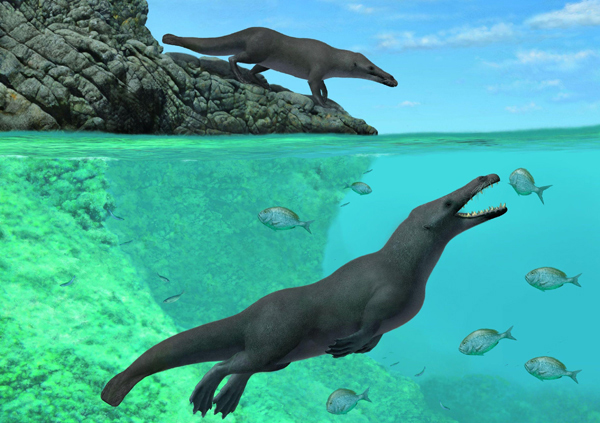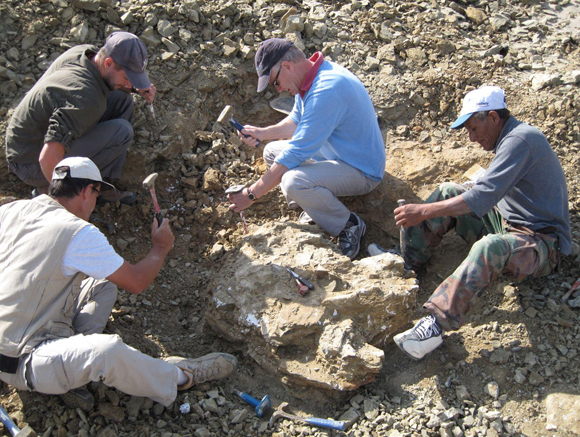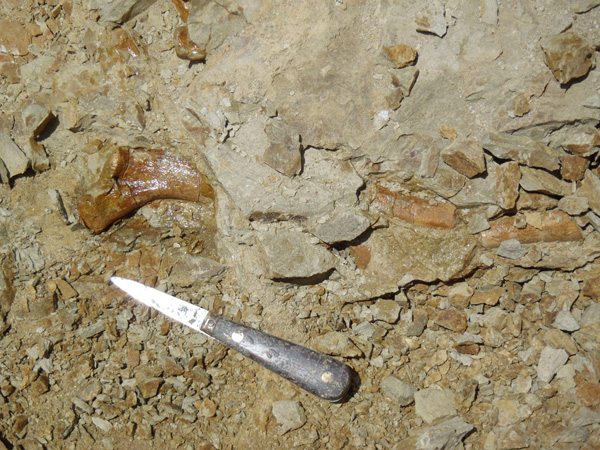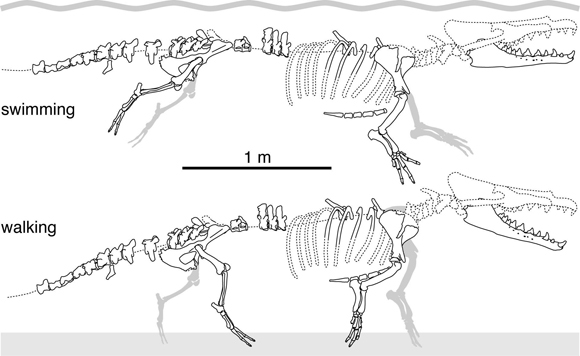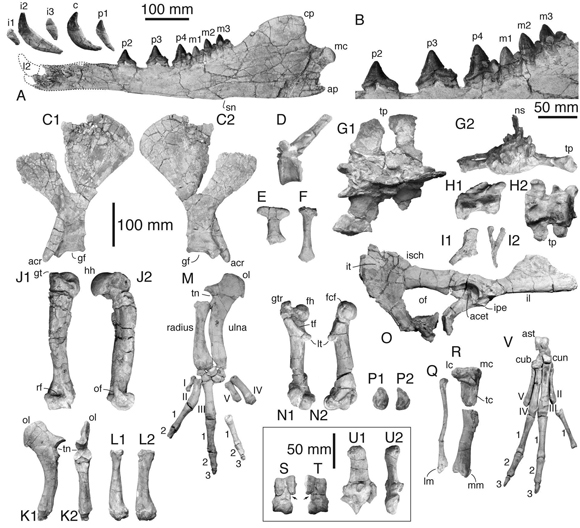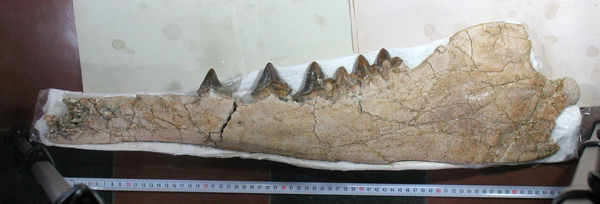Four-Legged Whale Ancestor from the Eocene of Peru
Peregocetus pacificus – The Travelling Whale that Reached the Pacific
A team of international researchers including scientists from Peru, France, Belgium, Italy and Holland have announced the discovery of an ancient four-legged whale from Peru. The fossil discovery suggests that early whales crossed the South Atlantic more than 42.6 million years ago (Lutetian faunal stage of the Eocene). The fossil material comes from the Playa Media Luna, in Peru’s desert-like Pisco Basin. It is the oldest fossil of a whale found to date in the New World.
A Life Reconstruction of the Newly Described Early Cetacean – Peregocetus pacificus
Picture credit: A Gennari/Royal Belgian Institute of Natural Sciences
Peregocetus pacificus
In 2011, an international team of palaeontologists excavated a well-preserved skeleton of a four-legged whale ancestor. Writing in the academic journal, “Current Biology”, the scientists conclude that P. pacificus illustrates a key phase in the evolution and dispersal of early whales. It represents the first record of an amphibious whale for the whole Pacific Ocean and its discovery supports the hypothesis for an early dispersal of primitive cetaceans to the New World across the South Atlantic.
Field Team Members Working on a Block of Fossil Bones
Picture credit: Christian de Muizon (Natural History Museum – Paris)
A Quadruped with a Powerful Tail to Assist with Swimming
The first whales are believed to have evolved around fifty million years ago, from terrestrial, hoofed, quadrupeds such as Indohyus from Kashmir. To read an article about Indohyus: Deer-like Fossil Confuses Whale Evolution. The discovery of Peregocetus pacificus will help to fill in some of the gaps in the fossil record of early members of the Cetacea. Dr Olivier Lambert of the Royal Belgian Institute of Natural Sciences and a co-author of the scientific paper stated:
“This is the most complete specimen ever found for a four-legged whale outside of India and Pakistan.”
A View of a Fossilised Rib of Peregocetus pacificus
Picture credit: G. Bianucci (University of Pisa)
The Oldest Four-legged Whale of the New World
Peregocetus combines terrestrial locomotion abilities and use of the tail for swimming, although the presence of a partial tail fluke as seen in the above illustration is speculative. Measuring between 3.4 to 4 metres in length, it probably resembled a large otter and like extant otters, it most likely hunted in the water and preyed on fish. The scientific name translates as “the travelling whale that reached the Pacific Ocean”, a reflection of this being the oldest New World whale fossil discovered to date. Although, not a complete skeleton, the fossil material represents the most complete skeleton of a four-legged whale outside India and Pakistan.
Olivier Lambert added:
“The animal could carry its own weight and crawl about on land. We can see this, among other things, because the pelvis is firmly attached to the sacrum and the front and hind legs are very similar to those of Peregocetus’s ancestors from India and Pakistan. You can even see marks of small hooves on the toes and fingers.”
Line Drawings Illustrating the Known Skeletal Material of Peregocetus in Swimming and Terrestrial Positions
Picture credit: Olivier Lambert (Royal Belgian Institute of Natural Sciences)
The picture (above), shows schematic drawings of the skeleton of Peregocetus in a swimming (top) and a walking stance (bottom), showing the main preserved bones. Stippled lines indicate reconstructed parts.
Like a Giant Otter
The researchers are confident that Peregocetus was an accomplished swimmer, perfectly at home in the water. The last few tail bones (caudal vertebrae), have not been found, so it is not possible to state whether this early whale had a tail fluke, but Lambert observed:
“The anatomy of the first vertebrae of the tail resembles that of amphibious mammals such as otters and beavers. So, we think the animal propelled itself through the water by wave-like movements of the posterior part of the body, including the tail, and by moving its large feet and long toes that were most likely webbed.”
Cranial and Postcranial Material (Peregocetus pacificus)
Picture credit: G. Bianucci (University of Pisa)
A Very Long Journey
The scientists suggest that the ancestors of Peregocetus crossed the Atlantic Ocean between North Africa and the northernmost portion of South America. During the Eocene, the Atlantic Ocean was only half as wide as it is today and the prevailing surface currents from Africa to South America would have helped the ancestors of Peregocetus to reach the other side. Once on the eastern coast of South America, the population gradually moved further northwards and populations were eventually established on the western (Peruvian) coast of South America. Later, relatives of Peregocetus would spread further north, to the east coast of North America.
The Prepared Lower Jaw of P. pacificus
Picture credit: Olivier Lambert (Royal Belgian Institute of Natural Sciences)
The Pisco Basin in Peru is proving to be hot-spot for whale fossils. In 2017, the international team with Olivier Lambert found, 200 metres away from the spot where Peregocetus pacificus was excavated, a 36.4 million-year-old descendant of the basilosaurids, identified as the oldest known member of the mysticete group – Mystacodon selenensis. Basilosaurids were fully aquatic and mainly used their tail fluke to propel themselves. Their front limbs had evolved into paddles and the rear legs were much reduced and vestigial.
There are two main types of whale alive today. Firstly, there is the Odontoceti (toothed whales), such as sperm whales, dolphins and porpoises. Secondly, there is the Mysticeti, the baleen whales such as the blue, humpback and gray whale.
Everything Dinosaur acknowledges the assistance of a press release from the Royal Belgian Institute of Natural Sciences in the compilation of this article.
Visit the Everything Dinosaur website: Everything Dinosaur.


